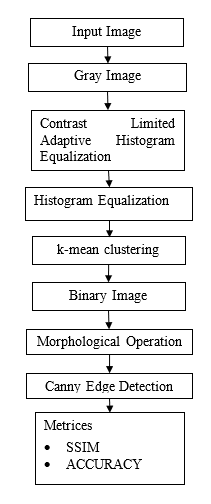K-means and Morphological Approach on Image Segmentation for Fish Detection
Objective
The primary objective of employing K-means clustering and morphological approach in the context of image segmentation for fish detection is to develop an effective and automated system for accurately identifying and isolating fish objects within underwater images
Abstract
Object detection using image segmentation by divide the image into several parts, such as the background and the object. However, object detection is difficult if the object and background have similar colors. This research performs image segmentation using K-means clustering to detect fish based on color and grayscale images. Before the segmentation, the acquired image needs to be preprocessed to increase image quality the image preprocessing used methods like cropping, resizing, and image enhancement.
The preprocessing results become input in the K-means segmentation. This method used K-means clustering, dividing (cluster) images into several parts by Euclidean distance. In the last step, the K-means segmentation is processed by morphology (opening and closing methods) to get the contours of the black-white (BW) fish image from color and grayscale.
Based on the experiments, as many as 100 fish images can be detected using the best k value is 8, and the accuracy is 84.48% to detect fish. Besides that, the structural similarity index measurement (SSIM) calculation returns values close to 1. This result means that the information is almost the same as the fish image. This segmentation can detect fish images with clearly segmented fish images.
Keywords— fish detection, histogram equalization, image processing, image segmentation, k-means clustering, morphology.
NOTE: Without the concern of our team, please don't submit to the college. This Abstract varies based on student requirements.
Block Diagram

Specifications
Software: Matlab 2020a or above
Hardware:
Operating Systems:
- Windows 10
- Windows 7 Service Pack 1
- Windows Server 2019
- Windows Server 2016
Processors:
Minimum: Any Intel or AMD x86-64 processor
Recommended: Any Intel or AMD x86-64 processor with four logical cores and AVX2 instruction set support
Disk:
Minimum: 2.9 GB of HDD space for MATLAB only, 5-8 GB for a typical installation
Recommended: An SSD is recommended A full installation of all MathWorks products may take up to 29 GB of disk space
RAM:
Minimum: 4 GB
Recommended: 8 GB
Learning Outcomes
· Introduction to Matlab
· What is EISPACK & LINPACK
· How to start with MATLAB
· About Matlab language
· Matlab coding skills
· About tools & libraries
· Application Program Interface in Matlab
· About Matlab desktop
· How to use Matlab editor to create M-Files
· Features of Matlab
· Basics on Matlab
· What is an Image/pixel?
· About image formats
· Introduction to Image Processing
· How digital image is formed
· Importing the image via image acquisition tools
· Analyzing and manipulation of image.
· Phases of image processing:
o Acquisition
o Image enhancement
o Image restoration
o Color image processing
o Image compression
o Morphological processing
o Segmentation etc.,
· How to extend our work to another real time applications
· Project development Skills
o Problem analyzing skills
o Problem solving skills
o Creativity and imaginary skills
o Programming skills
o Deployment
o Testing skills
o Debugging skills
o Project presentation skills
o Thesis writing skills




 Paper Publishing
Paper Publishing
